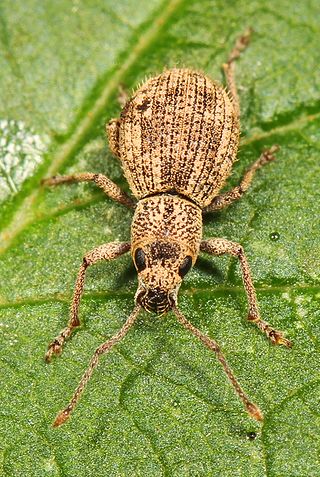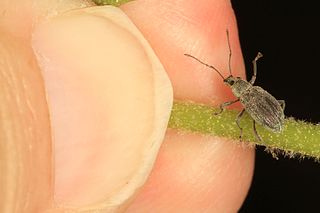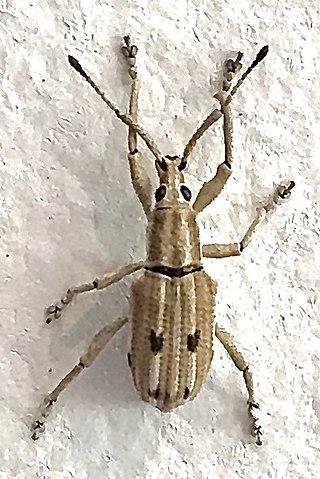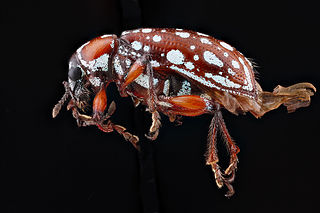
Weevils are beetles belonging to the superfamily Curculionoidea, known for their elongated snouts. They are usually small, less than 6 mm in length, and herbivorous. Approximately 97,000 species of weevils are known. They belong to several families, with most of them in the family Curculionidae. It also includes bark beetles, which while morphologically dissimilar to other weevils in lacking the distinctive snout, is a subfamily of Curculionidae. Some other beetles, although not closely related, bear the name "weevil", such as the biscuit weevil, which belongs to the family Ptinidae.

Otiorhynchus is a large genus of weevils in the family Curculionidae. Many species of the genus, particularly the black vine weevil and the strawberry root weevil, are important pests, both as larvae and as adults. Larvae feed on plant roots. Adults are flightless with fused elytra and feed at night on plant foliage. In many species of the genus at least some races are polyploid and parthenogenetic, while the rest of the races and species are diploid and bisexual. Otiorhynchus weevils, particularly O. scaber, have been a popular subject for studies of the evolution of parthenogenesis. The genus is native to the Palearctic region. However, sixteen species were inadvertently introduced to North America and have become widespread there.

Sitona is a large genus of weevils in the family Curculionidae native to the Nearctic and Palaearctic regions. Over 100 species have been described. Sitona is easily distinguished from related genera by flat, recumbent scales on the mandibles, by the absence of an oval scar on the mandibles, by short and broad rostrum with a deep, longitudinal, median groove, and by dense scales on the body.

Rhynchophorus, or common name palm weevils, is a genus of beetles in the weevil family, Curculionidae. Palm weevils are major pests of various trees in the family Arecaceae throughout the tropics including: coconut, Areca catechu, species of the genus Phoenix, and Metroxylon sagu. Two species are invasive pests outside their native ranges, Rhynchophorus ferrugineus and Rhynchophorus palmarum.

Pachnaeus is a genus of broad-nosed weevils in the family Curculionidae. There are about seven described species in Pachnaeus.

Stenoscelis is a genus of snout and bark beetles in the family Curculionidae. There are at least 30 described species in Stenoscelis.

Artipus is a genus of broad-nosed weevils in the beetle family Curculionidae. There are about 10 described species in Artipus.

Myllocerus undecimpustulatus, known generally as the Sri Lanka weevil or yellow-headed ravenous weevil, is a species of oriental broad-nosed weevil in the beetle family Curculionidae.

Pseudocneorhinus is a genus of broad-nosed weevils in the beetle family Curculionidae. There are about 11 described species in Pseudocneorhinus.
Tachygonus is a genus of flea weevils in the beetle family Curculionidae. There are more than 80 described species in Tachygonus.
Ochyromera is a genus of leguminous seed weevils in the beetle family Curculionidae. There are more than 30 described species in Ochyromera.

Pachyrhinus is a genus of pine needle weevils in the beetle family Curculionidae. There are more than 30 described species in Pachyrhinus.

Calomycterus is a genus of oriental broad-nosed weevils in the beetle family Curculionidae. There are about 11 described species in Calomycterus.
Cimbocera is a genus of broad-nosed weevils in the beetle family Curculionidae. There are about five described species in Cimbocera.

Cyrtepistomus is a genus of oriental broad-nosed weevils in the beetle family Curculionidae. There are at least 20 described species in Cyrtepistomus.

Pseudoedophrys is a genus of oriental broad-nosed weevils in the beetle family Curculionidae. There is one described species in Pseudoedophrys, P. hilleri. It originated in Japan, and can now be found in eastern North America.

Eustylus is a neotropical genus of broad-nosed weevils in the subfamily Entiminae, tribe Eustylini.

Exorides is a genus of broad-nosed weevils in the family Curculionidae, tribe Eustylini, distributed in northern South America.

Lachnopus is a genus of broad-nosed weevils in the family Curculionidae distributed in the Caribbean Region.

Xestogaster is a South American genus of broad-nosed weevils in the family Curculionidae.
















